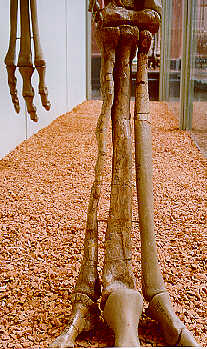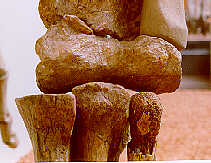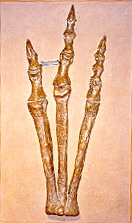
 In the meantime, thanks to Dave Unwin of the Museum fur Naturkunde in Berlin for sending me these photos of the metatarsus of the African specimen of Elaphrosaurus bambergi.
In the meantime, thanks to Dave Unwin of the Museum fur Naturkunde in Berlin for sending me these photos of the metatarsus of the African specimen of Elaphrosaurus bambergi.This page is reserved for discussion, rebuttal and comment on my article concerning Arkansaurus fridayi, in which I raised doubts about the authenticity of the dinosaur cast exhibits which have been on display in various museums around the state for over 25 years.
I got a couple of notes from former students of Dr. James Quinn, and while I was requested not to post the letters, they did provide some facts which I thought should be included, so here goes. 1) Quinn made three casts, but others were attmepted years later by others when the mold was old and crumbly. The condition of the mold might have been the reason the cast was not made in the usual way. It is those later casts, not made by Quinn, which were not supported in sand during manufacture. 2) According to Angela Braden's booklet cited in the original article, Dan Chure, a paleontologist with Dinosaur National Monument, is currently studying the find. (I had that information and neglected to include it in the original article. I should have.)
I spoke with Dan Chure, paleontologist at Dinosaur National Monument, on the phone (9/3/98), and he told me that he has the original bones and has had them for about a year and obtained them from the University of Arkansas Museum. He agreed to send me copies of photos of those fossils. Hooray! At last! A guy from New Jersey living in Utah is the only one who knows where the Arkansas fossils are kept.
Dan also told me that he made casts of the original unadorned bones and left them with the University of Arkansas Museum in case they wanted to display them. He doesn't think he has enough material to get a bona-fide species name for the find, but at least the find will be included in the scientific literature.
RTJ--9/3/98
I spoke with Dan Chure on the phone again on this most recent Monday and he assured me that, yes, he would this weekend get those photographs of the Arkansaurus fossils into the mail to me. He has been delayed because he has been working on his PhD thesis. Now that his thesis has been submitted, he will have time to get me that extra set of photos. Watch this space.
RTJ--1/12/99
I got a couple of notes from gvon@altavista.net and from tracy.vaughan@gte.net. The author(s) requested that I not reprint her(their) letters here. This is my reply to her note:
Dear Ms. Vaughan:
Thank you for your feedback concerning the Arkansaurus piece on my website.
I reread the article since recieving your note, and I don't think I accused anybody of faking the fossils.
I did find that Dr. Quinn's identification of the find as an Ornithomimus was not very satisfying and that the casts I saw more closely resemble those of Triassic dinosaurs like Liliensternus and Elaphrosaurus and not Cretaceous dinosaurs like Ornithomimus.
In the article I examined a number of possibile identifications concerning the bones. Since I was unable to locate the actual bones, the possibilty had to be considered that the find might not be genuine. The fact that the fakery scenario was examined last probably led you to feel that fakery was my conclusion.
Academic fakery made Piltdown Man a scientific fact for decades. A matter of aesthetic convenience put the wrong head on Brontosaurus and that head remained a scientific fact for years. T. Rex was long assumed by many to have an erect posture because the armature that held the display of the first complete skeleton would not support the bones in their proper positions. It is only responsible that somebody from time to time question the facts that scholarly authorities present to us. Critical examination of available evidence is the way science is done and should not be taken personally.
Furthermore, when I spoke to your parents I did identify myself.
Russell T. Johnson--1/13/99
Dear colleague (I'm uncertain of your name),
I've read your Arkansaurus site which I found while making lecture notes for my undergrad course on dinosaurs here at North Carolina State - my name is Dale Russell, and I'm writing to you from our home computer. I do dinosaurs professionally, and lived 30 years in Canada before moving to North Carolina, and thereby qualifying as a Southerner by choice.
I like the presentation you made on your web site, and wish to be kept posted. Did you ever visit the site from which the specimen was collected, and is it from an Antlers equivalent? Is the lithology more coarse grained than in Oklahoma? I agree with you that the foot is not ornithomimid, nor does it look like that of any coelurosaur (sensu strictu). However, Acrocanthosaurus (according to Paul Sereno, and I'm inclined to agree with him) looks like a carcharodontosaur - which as you know occur in Africa and South America in rocks of the same age. I agree that the foot looks like that of a ceratosaur (as you know they do occur in the Cretaceous of the southern hemisphere), but it could also be something else. And something that I couldn't identify, although I've worked on middle Cretaceous dinosaurs from Africa, because those dinosaurs are so poorly known. I would be reluctant the believe Arkansaurus is fake - yet. I,m interested in southern dinosaurs, because they were probably different to some extent from northern (e.g. Cloverly) dinosaurs.
But there are casts of Arkansaurus still around(?). It would be great to relocate the originals.
Thank you for exploring this interesting occurrence, and let's hope it may yet have a happy ending.
With all good wishes,
Dale Russell--1/23/99
Dear Dale:
Thanks for your note concerning the Arkansaurus article. As a matter of fact, there have been some developments concerning the find.
The most important is that a guy named Dan Chure who works at Dinosaur National Monument and who is on the verge of becoming a vertebrate paleontologist has (I am told) the actual fossils in his posession. I spoke with him recently (about once a month since posting the article) and he keeps promising to send me photographs of the actual bones.
Under most circumstances, I'd take things at face value, but Dan told me that he obtained the fossils from Mary Sutter at the University of Arkansas at about the same time she told me she didn't know where they were and that they might be at Texas Tech. That would have been around August of 1997. The fossils have been so darned elusive that I'd like carefully to compare the bones given him to the casts in our museums here.
There have also been problems with disappearing bones. The abstract of the original presentation by Dr. Quinn mentioned a couple of vertebrae (one caudal and part of a dorsal) found in the same beds (Trinity). Boy, if you want to tack down the identity as a coelurosaur, there's nothing like a couple of spine-bones! But Dan didn't mention any vertebrae. He also said he got only one claw and the abstract of Quinn's paper mentioned two claws (making the mix of bones in the Arkansaurus foot suspiciously similar to the mix of Liliensternus foot bones recovered).
I think you can see the problems I have with what was basically a literature review (and popular, not scholastic literature at that) on my part. The original scholarship was pretty sloppy. Dr. Quinn, while probably a fine geologist, was not a credentialled vertebrate paleontologist (and neither am I, for that matter). A properly lettered expert should have been consulted. The original evidence was elusive and the appropriate academic authorities in Arkansas couldn't agree on where the bones were as of August 1997. It is that frustrating sloppiness that forces me to consider the possibility of fakery. Believe me, I'd rather have a real Arkie dinosaur than a fake one any day!
Examining what evidence there is has been pretty exasperating, though, let me tell you. At the Arkansas Museum of Science and History at MacArthur Park, the lady at the front desk wouldn't let me take a picture of the cast! Eventually the cast was moved to the Museum of Discovery and I got the picture there.
You asked me some things I don't know and I'll have to get back to you on them. For example I don't know what an "Antlers equivalent" is, and I'll have to look up the Sereno reference to know what you're talking about there. Both acrocanthosaurus and carcharodontosaur are identified mainly by skull material so I'm guessing you're not suggesting alternate identifications. The skulls apparently share some important diagnostic characteristics, yet one is from Algeria and the other from Texas. Perhaps you are suggesting that similarities between Arkansaurus and various old world dinosaurs like Liliensternus might be similarly coincidental? Possibly, although convergent evolution or even plain coincidence might be a more comfortable explanation if there were more than one dinosaur foot found in the Trinity beds in Lockesburg.
I did not know that the ceratosaurs persisted into the Cretaceous in the southern hemisphere. Can you give me some examples so I can compare them to Arkansaurus? The strata that contained the Arkansaurus fossils are from the lower Cretaceous, according to the Quinn abstract.
You asked about the texture of the Lockesburg matrix relative to similar strata in Oklahoma. Sorry, don't know. I've taken pictures of the Friday farm from the road, but not of the pit where the bones were found. Mr. Friday told me on the phone that the pit that yielded the bones is now filled with water and that therefore I couldn't examine the rocks there. And I probably can't go back there for another look because Susan Friday Vaughn saw my article and she wrote to me and I think I've cheesed them off. I have not examined any excavations in Oklahoma.
However, there's a huge gravel mining operation just across the road within a hundred yards the Friday farm. It was one of the guys there that pointed out the Friday property for me. If you'd like me to examine those pits, I could possibly get some pictures and specimens from various layers. I'm a chemist/biologist myself. What little I know about paleontology and geology I've picked up on my own, but I should be mightily keen to compare the actual fossil minerals to actual lower cretaceous rocks from "across the road." Another thing which should have been done at the outset.
The original mold made by Dr. Quinn has crumbled to dust, but I have photos of all three of the casts he made and I look forward to seeing the Chure photos. Dan Chure told me that he made replicas of the bones that Mary Sutter gave to him and that she has them in the museum at the University of Arkansas at Fayetteville. I have not examined those replicas, but it might not be a bad idea.
In the next month or so I'm going to be posting a story about some sauropod tracks that were found by a geology graduate student in a gypsum quarry near Nashville, AR in 1984. You might find it useful to show your students a story where everything was done right and contrast it with the Lockesburg find, where everything was done wrong. Doing everything right in the first place makes things easy for people who have to examine the data years later, and by-the-book science keeps smart alecks like me from raising the uncomfortable question of fakery.
Russell T. Johnson
I've been calling Dan Chure at Dinosaur National Monument every couple of months since I last posted to this feedback page. Each time he says he's got the photos of the actual bones and will send them to me at his first opportunity. He told me that his wife found this article and he is properly embarassed.

 In the meantime, thanks to Dave Unwin of the Museum fur Naturkunde in Berlin for sending me these photos of the metatarsus of the African specimen of Elaphrosaurus bambergi.
In the meantime, thanks to Dave Unwin of the Museum fur Naturkunde in Berlin for sending me these photos of the metatarsus of the African specimen of Elaphrosaurus bambergi.
 On the right is Arkansaurus fridayi again. Judging from the knobby process on the proximal end of metatarsal III (the middle one), and judging from the relative proportion of metatarsal II to its neighboring phalange, this is a much much much much better match for Arkansaurus than Liliensternus. In fact, the middle metatarsal of each specimen is about 390mm, so they've got the same size foot at least. The aforementioned Dan Chure said that this really wasn't enough to go on to positively ID the Arkansas specimen as Elaphrosaurus, but that Elaphrosaurus fossils have been found in the new world as well as the old. Also, Elaphrosaurus comes under the general heading of Ornithomimosauria, which makes James Quinn's original identification look a lot better.
On the right is Arkansaurus fridayi again. Judging from the knobby process on the proximal end of metatarsal III (the middle one), and judging from the relative proportion of metatarsal II to its neighboring phalange, this is a much much much much better match for Arkansaurus than Liliensternus. In fact, the middle metatarsal of each specimen is about 390mm, so they've got the same size foot at least. The aforementioned Dan Chure said that this really wasn't enough to go on to positively ID the Arkansas specimen as Elaphrosaurus, but that Elaphrosaurus fossils have been found in the new world as well as the old. Also, Elaphrosaurus comes under the general heading of Ornithomimosauria, which makes James Quinn's original identification look a lot better.
There's still one thing that bothers me. Elaphrosaurus was a jurassic dinosaur. Like Liliensternus and the rest of the dinos with parallel metartasal arrangements, it was not around during the cretaceous, during the formation of the rock in which its bones were found. It just seems that there's always a piece that doesn't fit.
RTJ--12/5/2000